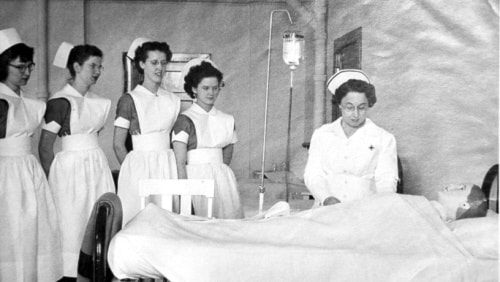By Treena Mielke
The year was 1942 and Vera Slater was 17 years old, fresh off the farm, frightened and unsure, when she first darkened the doors of the Alberta Hospital, ready to begin a new career in a field that was filled with more unknowns that she could even begin to imagine.
She had come from a small rural area near Drumheller and answered the call of psychiatric nursing — mostly because there was a need for such nurses at that time and she was too young to qualify for the nursing program at the Calgary General Hospital.
“They needed living, breathing people so there I was. But it was a vast shock. It was simply overwhelming.”
Slater, however, young as she was, soldiered on and proved to have a work ethic that held her in good stead throughout a long and successful career.
She completed the four-year training program, graduating as a psychiatric nurse and a registered nurse. Her dual training would have given her more options, but she decided to stay at Alberta Hospital.
She worked there for 34 years, leaving in 1949 to marry and raise her family, but she returned in 1961 and worked at the hospital as head nurse until 1986.
As a 1946 graduate, Slater, no doubt, experienced long hours and low pay, coupled with responsibility she couldn’t have even begun to fathom as a young girl.
With the outbreak of the Second World War, many staff left for the services or higher paying jobs in industry, creating a shortage of nurses and constantly changing junior staff.
Overcrowding continued and existing buildings were in a state of disrepair.
In 1942 medical staff consisted of three doctors and a medical superintendent. By 1949 the patient count had stabilized at 1,400.
The introduction of tranquilizing drugs in 1953 was a huge turning point in the treatment of mentally ill patients, said Slater. “It was very positive and many auxiliary treatments radiate from them (their usage).”
The most common drug was largactil (chlorpromazine). Although this drug had side effects, these were alleviated by Artaine in 1954.
Slater believes the introduction of tranquilizers resulted in fewer patients as the drugs reduced their symptoms and allowed them to be integrated back into society.
Gerry Mark graduated with Slater in 1946. At 19, she was two years older than her classmate and affectionately refers to her as “the baby of the class.”
She too, recalls being very frightened when she began training. “I was scared; we were all scared.” However, she, too, settled into the routine of work and classes quickly and even adjusted to the 12-hour six-days-a-week shifts.
She said many patients suffered from schizophrenia, anxiety and depression and treatments ranged from severe measures such as pre-frontal leucotomies and electroconvulsive, hydro and insulin coma therapies to occupational therapy, hot and cold baths and being placed in side rooms.
The nurse to patient ratio was 150:8 and it was difficult to provide anything but the most base of mental and physical care.
Mark recalled one patient who used to catch mice and took great pleasure in showing the nurses how she ate them alive.
Such behavior may have been avoided if there had been more nurses on staff, but Mark recalls she, like her co-workers, simply did the best they could and carried on.
Nurses in training at Alberta Hospital were given a living allowance of $25 a month, plus room, board and laundry.
By the end of the Second World War, nurses and attendants worked eight-hour shifts and received approximately $125 per month, less room, board and laundry.
Barb Greshner, who graduated as a psychiatric nurse and a registered nurse in 1958, also recalls an experience with mice. She was standing at attention in front of a superior when a mouse ran across her foot.
“I didn’t dare move,” she said. “It was an awful experience.”
Greshner, who worked at the hospital for 28 years, saw many changes over the years.
She noted that shortly after the opening of the Ponoka Insane Asylum on July 4, 1911, the story has been told that a group of 164 patients from the mental hospital in Brandon, Man. arrived at Ponoka’s depot.
Those able to walk were shackled together as they walked to the Ponoka Insane Asylum.
“Our aim was to take off those shackles,” she said. “And we did the best we could with what we had. There was a real work ethic and there was caring, not only for the patients, but for our coworkers, as well. “
Greshner said the farm that produced vegetables, eggs, milk and meat was a wonderful asset to the hospital, not only providing patients with work therapy, but as a source of food for the facility.
Greshner, who spent some time teaching nursing at the Alberta Hospital, believes education continues to be a very important aspect of mental health.
“Having educated people to work with those suffering from mental health issues is very important,” she said.
